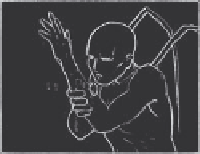Graphics Reference
In-Depth Information
From my experience, most professional stop motion animators (me included) are a little odd. We tend
to be insecure, a little inadequate in certain areas of our lives, battling for control over our lives or
feelings. That's why stop motion appeals to me. I can express myself and control every aspect of the
medium … its fair to say I enjoy playing god, with a need to control. I know when life gets a little scary
and unpredictable I can release my frustrations acting through a puppet. Some take this further by
becoming directors, producers or even setting up their own studios, controlling their own puppets in
the form of staff … This industry attracts its fair share of nutters, who can't cope with real life and hide
themselves in the realms of children's television, but saying that as one of these nutters, it's a wonderful
environment to be a part of.
As a professional stop motion animator I work in studios on shows with rules and constraints of a world
that has been predesigned and developed. There are frustrations, and restrictions, and lazy, diffi cult
and easily threatened staff, but you realise it's like any other job, until you are lucky enough to get on
a 'magic crew!', then the studio becomes something else, a wonderful creative environment. You have a
group of people, with many of things in common all working towards a certain goal. That's a rare and
very special feeling. When it happens that special something is there in the end result.
Stop motion intrigues everyone. Its popularity over the years has made it an acceptable cartoon medium
alongside 2D and now CG animation. What it has is something extra, a novelty factor attached to it. The fact
that every aspect is manmade, crafted, lit and moved; it's like live action in many ways but on a miniature
scale … and slower. People who watch know it exists for real, that that puppet has been animated by human
hands … For me, anything is possible in stop motion, if a little expensive, but it's all worth it!
Kenneth Grahame does not help stage or i lm adaptations (but then the topic was never written
for publication) as the characters change size from page to page, and swing from humanistic to
more animalistic just as easily. The original design for Toad had his bottom rather low, and his
long legs slightly splayed in a crouching position. This looked fantastic in a drawing and caught
the 'toad' element very nicely, and a drawn i lm could have moved him perfectly, stretching and
squashing, cheating on the physical restraints that solid anatomy brings. But with a puppet and
its solid mechanics, walking like this would have been absurdly dii cult. He couldn't move his
legs forward in a parallel manner, but would have had to swing his legs round the outside of
his hips. Since both Grahame and the animators had in mind an elegant, if hugely pompous,
gentleman, this would have defeated the purpose. Toad's legs were moved from the outside his
body to underneath him, making him a somewhat portly man with a big head. This enabled him
to walk with some sense of style rather than a lurch. Toad was blessed with beautifully long legs
and arms, and I used both to give as much expression as possible. Too often animated characters
have large, round bodies and tiny stumpy legs …. A nightmare, I'm afraid. Short arms are
especially a nightmare as we resort to human gestures. The vocabulary becomes limited if the
arms cannot reach the face or cross the stomach. Long limbs suit my style of animation.
Oh, but what a puppet Toad was! The armature for this puppet still exists today
and is a little marvel. Initially, the sculptors struggled to i nd the right proportions.
A little toad head sitting on a neck atop a human body looked daft, as did the
realistic anatomy of a toad head seamlessly joining the body. The distinguishing
features of a toad are the large mouth and those eyes, both of which we
emphasised. One reason for i lming
The Wind in the Willows
in that point of



Search WWH ::

Custom Search